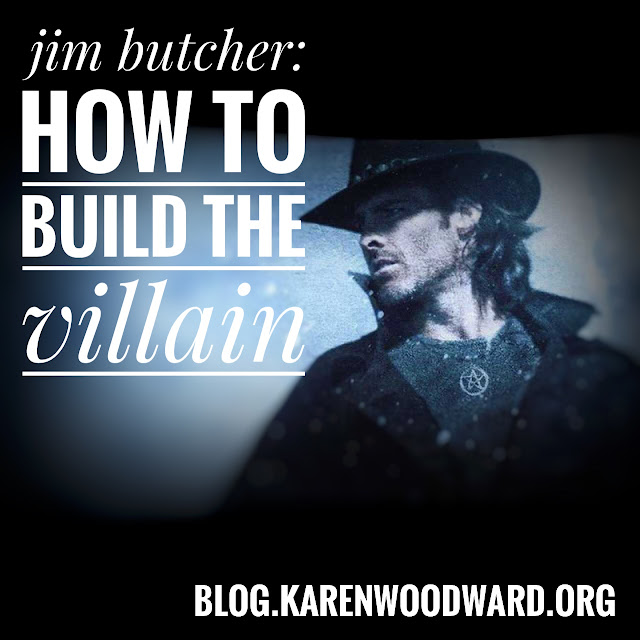I love Jim Butcher's series, The Dresden Files. I marvel at his well-rounded characters, his engaging fight scenes, the way he chains together scenes and sequels to create reader engagement, and the way he seamlessly weaves in backstory. Oh, and his fight scenes are epic. And that's just off the top of my head! Now that's my kind of writer.
Given that lead-in, you can understand why I get excited when I find an article Jim Butcher has written about the craft of writing. Today was a very good day. I found, "How to build a Villain," on a the site: Magical Words: Writing tips and publishing advice for aspiring novelists.
So, how do you build a villain? Jim Butcher writes:
One of the most critical skills an aspiring writer needs is the ability to build a solid villain. Even the greatest protagonist in the world cannot truly shine without an equally well-rendered opposition. The converse of that statement isn’t true, though—if your protagonist is a little shaky but your villain absolutely shines, you can still tell a very successful story.
How to Build a Powerful Villain:
"Your villain has to be motivated even more strongly than your protagonist, to move in a direction that is opposite to your protagonist’s goal. The drama and tension of the entire story is based upon those two opposing forces. Buffy versus vampires. Sith versus Jedi. Spy versus spy."1. Motivation
"Your villain has to have enough power, of whatever nature, at his disposal to make him a credible threat to your hero. Personally, I believe that the more the villain outclasses the hero, the better. David wouldn’t have gotten nearly the press he did if Goliath had been 5’9” and asthmatic."2. Power
"Every serious 'big bad villain' you write ought to have facets of his personality that are desirable, even admirable. Perhaps your villain is exquisitely polite and courteous, extremely perceptive, remarkably intelligent, or possessed of a skewed sense of honor that makes him something more than a simple black-hat. In point of fact, a villain might be loaded down with admirable qualities, all of which should serve to only make him even more dangerous to your protagonist. Think of the Mayor of Sunnydale in “Buffy the Vampire Slayer.” Except for the part where he was trying to turn himself into a giant demon and devour the graduating class, he was a great guy!"3. Admirable Qualities
"A good villain needs to be instantly recognizable to your reader, so that even if he hasn’t appeared in a hundred pages, your reader will recognize that character instantly. You can achieve this pretty effectively using Tags and Traits, identifiers for a character which reserve particular props, personality traits, and words to associate with any given character. You can find an article that goes into them in greater depth on my livejournal at jimbutcher.livejournal.com."4. Individuality
Above, Jim Butcher mentioned an article he posted on his Livejournal site. He has actually posted quite a few excellent articles to that blog.
Jim Butcher goes on to say:
"I have a standard operating procedure for creating characters. I keep a dossier on each of them. When the character is created, I open a new file and fill in name, goal, description, tags, and traits. I write down a brief summary of what their capabilities are, and more fully describe their goals and motivations. If it’s a recurring character, I keep a running log of their development: how have the events of the story world affected them? How have they changed as a result? What are they likely to want in the future?That is the end of the article but in the comment section Jim Butcher continues to give helpful advice to writers.
"If you’re going to take anything away from this post, it’s this: Villains are even MORE important to build well than are heroes.
"Spend every bit as much time and effort crafting your villain as you do the hero, and make sure that you motivate your villains every bit as thoroughly as you do your protagonist, or your story risks a lack of depth and contrast. In other words, it’ll be the one thing a fiction writer cannot afford to be: boring."
Question: “I’m intrigued by this idea of Tags and Traits. I’m guessing these are like the natural evolution of Homeric Epithets?”
Jim's Answer: I haven’t heard them described in those terms, but yeah, that fits, though the goal is to use it with a little more subtlety. Tags are words you use to physically describe any given character. Traits are aspects of their personality.Question: “I wonder how important it is to reveal outright the villain’s weakness? Or is that revealed by the demise of the villain in the story process?”
For example, the tags for Karrin Murphy in the Dresden Files are words like “tiny,” “cute,” and “blond.” Her traits are words like, “tough,” “smart,” and “fierce.”
The goal is to create a kind of mental signature for any given character, so that the reader need not consciously labor to identify who is speaking, and so that a very clear impression of the character is created when that character is introduced.
It all feeds into the idea that the goal, as a writer, is to create a kind of virtual reality in the head of the reader. That works best when the actual mechanics of words and sentences are as transparent as you can possibly make them. Part of making them transparent is to identify a few words or phrases so strongly with a given character that the reader doesn’t really notice the words themselves–they only see the character to which you’ve connected those words and phrases.
Jim's Answer: Who says the villain has to /have/ a weakness? Though if you are going to go for a villain with a 2-meter exhaust port vulnerable to photon torpedoes, you can certainly do that. I did it with the Loup-garou in Fool Moon, after all. But most of the villains in the Dresden Files don’t have a silver-bullet weakness. It makes their takedown (if they’re going to be taken down) a little too simple and predictable.Question: “What is your approach, or rather your thoughts so I don’t make you feel all spoilery, on hinting at the big bad’s fingerprints in the early parts of your story arc without jumping the gun and revealing too much about them and their agenda?”
“But there are plenty of great villains that don’t have anything admirable about them. They’re just freaking monsters. Like The Joker, or Darth Sidious. I do prefer admirable villains, but i’d be lying if i didn’t enjoy the occasional complete monster. Are they just the exception that proves the rule or what?”
The Joker is crazy brilliant, literally, and he has style. It’s a bombastic and cartoony style, much of the time, but it’s still style. And Darth Sidious just wasn’t all /that/ great a villain, at least in my opinion–but even so, he was intelligent, eloquent, and a capable administrator. I mean, he conquered a whole galaxy. You don’t do that without at least a little talent. :)
“when I write a villain character, I seem to get so into “it” that I sometimes find it hard to not keep wanting to take it further and further (great for future books), but once I get to the point where “hey, it’s time to end this book”, how do you cut yourself off an say enough!”
Just remember that the end of your story is the answer to a question: will your hero succeed in his goals when the villain gets in his way? If your hero has achieved his goals, you’re done, that’s it, wrap it up and start on the next story.
“Is it dangerous to spend too much time with the villain/antagonist up front like this? I have a strong and familiar archetype for the protagonist and I keep saying “ah, he’ll be no problem when I get to his part”, so I keep putting off the details of his development. Conversely, the antagonist, being an immortal, figures heavily into the state of the world and the trials that will be put before the hero. Am I falling into a noob-trap here?”
Possibly, but it’s not one that can’t work out well for you. I mean, look at how well that one went for JK Rowling. When you think about it, Voldemort shaped absolutely EVERYTHING that happened in the Harry Potter books, right down to the scar on the hero’s head and his mysterious ability to speak with snakes. Why did it work? Because Voldemort, with his own actions, forged Harry into the means of his own demise. Harry, meanwhile, is sort of unremarkable as a hero, in a personal sense. He’s brave, but no braver than many other folk in the HP universe. He’s smart, but not the smartest around. He’s not even the best at magic. Voldemort made everything about him that was truly remarkable.
That said, I think it’s /far/ smarter to build your hero with every bit as much attention as your villain. Batman versus the Joker works so well precisely because they were designed with one another in mind, as champions of order and chaos, respectively. More importantly, it gives you double the audience appeal potential. I’ve read books where I just couldn’t stand the heroes, but loved the villains, and so continued. But the books that stay with me the longest are the ones who are solid all the way across the board, who fully engage me with their entire cast.
That’s mostly a matter of taste, but do yourself a favor and assume that the readers are smart. They are. Drop hints without being too overly dramatic about it, if you’re going to keep the identity of your villain hidden for a while, and make sure that you’ve got a villain to defeat in effigy before the end of the story. Think of, oh, Darth Maul and Palpatine. Palpatine may have been briefly stymied by the Jedi, but Maul got chopped up and thrown down a killin’ hole. His death was symbolic of Palpatine’s demise–literally, since Palpatine got thrown down a killin’ hole too.That's it! If you like my content please consider supporting me on my Patreon account. If you support the blog for just one dollar a month I'll send you my book, "The Structure of a Great Story."
“Having read all of the Dresden based novels, I am quite aware that your protagonist is deeply flawed and often those who act as antagonists display character traits that are admirable. Given this near equality, how does one avoid having everyone be candidates for “villian” status?”
Storytelling craft is not about making moral judgments of the relative values, ethically or otherwise, of your character’s actions. The readers will do that for themselves. For craft purposes, the protagonist is the one who is going after his goal. Your antagonist is getting in the way of that goal. “Hero” and “villain” are both separate terms which can overlap with protagonist and antagonist, but they aren’t absolutely bound together. Think of The Fugitive again. Sam Gerard is a perfect example of an antagonist who is, in fact, personally heroic. Artemis Fowl and Megamind are good examples of a protagonist who is personally a villain.
But don’t try to make the call for your readers. Just tell the story. They’ll do the rest on their own.
By the way, I've added a tier to my Patreon where I'll critique about 2,000 words per month. Send me anything! A short story, a section of your work-in-progress, a script, a recipe! It doesn't matter. I've limited this tier to 15 people.
Thanks for reading and I'll talk to you again soon! :-)










